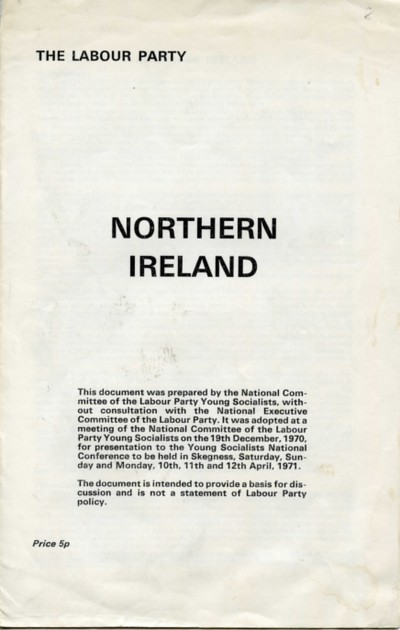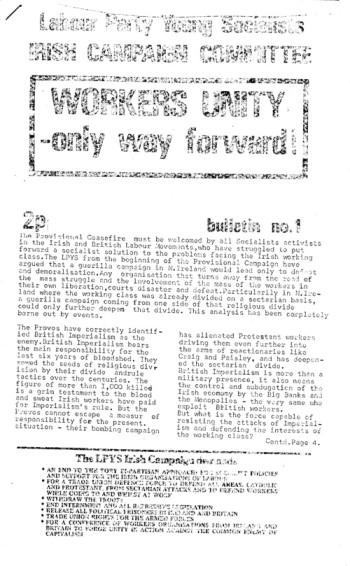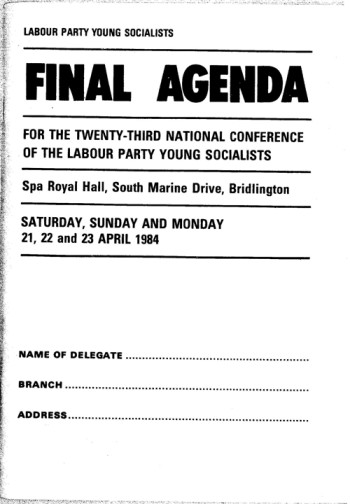Northern Ireland

| Date: | April 1971 |
|---|---|
| Organisation: | Labour Party Young Socialists |
| Collection: | The British Left on Ireland |
| Type: | Conference Report |
| View: | View Document |
| Discuss: | Comments on this document |
| Subjects: |
Please note: The Irish Left Archive is provided as a non-commercial historical resource, open to all, and has reproduced this document as an accessible digital reference. Copyright remains with its original authors. If used on other sites, we would appreciate a link back and reference to The Irish Left Archive, in addition to the original creators. For re-publication, commercial, or other uses, please contact the original owners. If documents provided to The Irish Left Archive have been created for or added to other online archives, please inform us so sources can be credited.
Commentary From The Cedar Lounge Revolution
17th February 2020
Many thanks to the person who forwarded this to the Archive.
The Labour Party Young Socialists were, as noted here,
The Labour Party Young Socialists (LPYS) was the name of the youth section of the British Labour Party from 1965 until 1993. The LPYS was the most successful of the youth sections of the Labour Party in the post war period, at one point having nearly 600 branches and attendances at its national conference of nearly 2000 in the mid-1980s, publishing a monthly newspaper Socialist Youth, during which time it was under the leadership of the Militant tendency.
This twelve page document was as noted on the front cover:
Prepared by the National Committee of the Labour Party Young Socialists, without consultation with the National Executive Committee of the Labour Party. It was adopted at a meeting of the National Committee of the Labour Party Young Socialists on the 19th of December, 1970, for presentation to the Young Socialists National Conference to be held in Skegness, Saturday, Sunday and Monday, 10th, 11th and 12th April, 1971.
And:
This document is intended to provide a basis for discussion and is not a statement of Labour Party policy.
In the introduction it argues:
The events in Northern Ireland of the past two years have rudely forced the Tories skeleton from its cupboard. Quite rightly described as the ‘worst political slum in Europe’ the state of NI has been ruled for 50 years by a regime based on gerrymandered election, deliberately fostered religious sectarian hatreds with all the consequent discrimination and brutal terror. Even now, after mass uprisings in Derry and parts of Belfast, many elementary democratic rights are still denied. For example: one man – one vote is not universal and multiple property votes still exist.
It notes the ‘mass uprising of the Catholic population of Derry in 1969’ and how ‘the mass movements which have developed in recent years are not only the result of sectarian violence and oppressions… throughout the show of Ireland, the economic and social changes of the past twenty years have brought about an entirely new situation whereby the new generations are not prepared to be trampled on in the same old way.’
And it argues that, having noted increased rates of strikes in the South and the fracturing the unionist political structures:
The possibilities which now exist for the working class movement in Ireland both North and South developing along class lines, with socialist ideas to break the old sectarian divisions, are great. The opportunities for the socialist movement, and in particular among the youth, are tremendous.
There are various sections which cover the broad history, examine Partition, The State of Northern Ireland, Changed Situation, Civil Rights and so on. It claims that ‘in parts of East Belfast, joint Catholic and Protestant street committees were set up to protect the area from hooligan attacks and to maintain the peace, with the working class residents organising patrols’.
That said mention of paramilitaries is surprisingly scant:
Those advocating the purely military road, without the involvement of the mass of the workers are trying to substitute themselves for the forces of the workers as a whole moving towards the socialists transformation of society.
On the other hand, the motives of the leadership of the right wing of the republican movement are not so honest. The ‘Provisionals’ who split away from the mainstream because of the newly-developed ‘socialist’ leanings of the Sinn Fein, quite clearly aim to ‘solve’ the situation by proving so much chaos that either the Irish army or the United Nationals will be forced to intervene and ‘unite’ the country. Many of the recent sectarian attacks on protestant working class areas can be laid at their door.
More from Labour Party Young Socialists
Labour Party Young Socialists in the archive


Comments
No Comments yet.
Add a Comment
Comments can be formatted in Markdown format . Use the toolbar to apply the correct syntax to your comment. The basic formats are:
**Bold text**
Bold text
_Italic text_
Italic text
[A link](http://www.example.com)
A link
You can join this discussion on The Cedar Lounge Revolution
By: pettyburgess Mon, 17 Feb 2020 15:56:36
Interesting how “green” this is by the more recent standards of the Socialist Party.
Reply on the CLR
By: Joe Mon, 17 Feb 2020 17:39:35
In reply to pettyburgess.
Not sure what, if any, group was in control of the Labour Party Young Socialists (LPYS) at the time that pamphlet was produced. So I don’t think the document should be necessarily seen as being the work of Militant or whatever what became Militant was called at that time.
Reply on the CLR
By: WorldbyStorm Mon, 17 Feb 2020 17:58:04
In reply to Joe.
Wiki suggests that it was just prior to their period of dominance but that they had considerable influence.
“However, during the late 1960s the Militant tendency began to win significant numbers of resolutions at the LPYS National Conference. In 1969, resolutions moved by Militant supporters won majorities on all issues except the question of the United Nations, and in 1970 all resolutions moved by Militant supporters were passed, although in order to be passed they had also to be supported by other groups. By 1972, the Militant tendency had gained a majority on the LPYS National Committee.[2]”
That said it was early in the conflict and approaches might not have been quite so set in stone at that point.
Reply on the CLR
By: Jolly Red Giant Mon, 17 Feb 2020 18:59:17
It certainly has the hallmarks of a Militant produced document. I could even give a guess at who wrote it – but I have asked comrades in Britain if they have any knowledge of the origins of the document.
Reply on the CLR
By: Joe Mon, 17 Feb 2020 19:56:21
I suppose, going back to pettyburgess’s original comment, the document could be read in the knowledge that, if I’m not mistaken, Ted Grant’s faction after he split from Militant/SP built links with the IRSP and that the SPEW/CWI Ireland group more recently has taken a more ‘green’ line than the SP here. As far as I know.
Reply on the CLR
By: Jolly Red Giant Mon, 17 Feb 2020 20:12:11
For many decades the common swipe against the Socialist Party was that it was being dictated to from London – recent events have demonstrated that this was not (and never was) the case. It has also been claimed that the Socialist Party’s analysis of the national question was dictated from Britain – again, the reality was that the CWI’s analysis on the national question came about largely as a result of the work of the Irish section and resulting from intense discussions based on a study of Marxist writings and an analysis of the history of the national question in Ireland.
Reply on the CLR
By: Jolly Red Giant Mon, 17 Feb 2020 20:13:02
In reply to Jolly Red Giant.
N.B. – This document looks like it was written during the course of these discussions.
Reply on the CLR